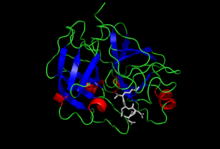Enteropeptidase
| enteropeptidase | |||||||||
|---|---|---|---|---|---|---|---|---|---|

Crystal structure of Enteropeptidase with an inhibitor
|
|||||||||
| Identifiers | |||||||||
| EC number | 3.4.21.9 | ||||||||
| CAS number | 9014-74-8 | ||||||||
| Databases | |||||||||
| IntEnz | IntEnz view | ||||||||
| BRENDA | BRENDA entry | ||||||||
| ExPASy | NiceZyme view | ||||||||
| KEGG | KEGG entry | ||||||||
| MetaCyc | metabolic pathway | ||||||||
| PRIAM | profile | ||||||||
| PDB structures | RCSB PDB PDBe PDBsum | ||||||||
| Gene Ontology | AmiGO / EGO | ||||||||
|
|||||||||
| Search | |
|---|---|
| PMC | articles |
| PubMed | articles |
| NCBI | proteins |
| protease, serine, 7 (enteropeptidase) | |
|---|---|
| Identifiers | |
| Symbol | PRSS7 |
| Entrez | 5651 |
| HUGO | 9490 |
| OMIM | 606635 |
| RefSeq | NM_002772 |
| UniProt | P98073 |
| Other data | |
| Locus | Chr. 21 q21 |
Enteropeptidase (also called enterokinase) is an enzyme produced by cells of the duodenum and involved in human and animal digestion. It is secreted from intestinal glands (the crypts of Lieberkühn) following the entry of ingested food passing from the stomach. Enteropeptidase converts trypsinogen (a zymogen) into its active form trypsin, resulting in the subsequent activation of pancreatic digestive enzymes. Absence of enteropeptidase results in intestinal digestion impairment.
Enteropeptidase is a serine protease (EC 3.4.21.9) consisting of a disulfide-linked heavy-chain of 82-140 kDa that anchors enterokinase in the intestinal brush border membrane and a light-chain of 35–62 kDa that contains the catalytic subunit. Enteropeptidase is a part of the chymotrypsin-clan of serine proteases, and is structurally similar to these proteins.
Enteropeptidase was discovered by Ivan Pavlov, who was awarded the 1904 Nobel Prize in Physiology or Medicine for his studies of gastrointestinal physiology. It is the first known enzyme to activate other enzymes, and it remains a remarkable example of how serine proteases have been crafted by evolution to regulate metabolic pathways. The inert function of digestive enzymes within the pancreas was known, as compared to their potent activity within the intestine, but the basis of this difference was unknown. In 1899, Pavlov’s student, N. P. Schepowalnikov, demonstrated that canine duodenal secretions dramatically stimulated the digestive activity of pancreatic enzymes, especially trypsinogen. The active principle was recognized as a special enzyme in the intestine that could activate other enzymes. Pavlov named it enterokinase. The debate of whether enterokinase was a cofactor or enzyme was resolved by Kunitz, who showed that the activation of trypsinogen by enterokinase was catalytic. In the 1950s, cattle trypsinogen was shown to be activated autocatalytically by cleavage of an N-terminal hexapeptide. The more precise IUBMB name enteropeptidase has been in existence since 1970. However, the original name ‘enterokinase’ has a long history and remains in common use.
...
Wikipedia
